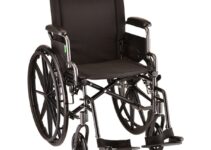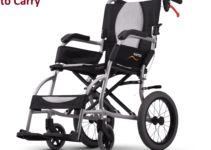Are you or someone you know living with a disability? If so, then you understand the importance of cushioning and proper wheelchair support. Pressure sores can cause extreme discomfort and even long-term damage if not addressed.
This article will cover how cushions for wheelchairs can be used to help prevent pressure sores. You’ll learn the different types of cushion options, as well as the benefits they offer. Get ready to make more comfortable choices!

Cushions are a critical component of an effective pressure relief system, as they can provide protection against uncomfortable contact between the user’s skin and wheelchair seat surfaces. When properly chosen and used, cushions can reduce the risk of developing pressure ulcers while promoting comfort and prolonging mobility.
This guide will outline the importance of cushion selection and provide helpful information on assessing individual needs, choosing the right cushion for each person, and ensuring proper application to ensure maximum benefit. It is important to consider all factors involved when determining the best solution for each individual’s needs—from preferred seating material to lifestyle habits. With this knowledge in hand, an informed decision can be made as to which type of cushion is right for you or your loved one.
Explanation of the importance of preventing pressure sores in wheelchair users
Pressure sores are a common and potentially serious complication of long-term confinement to a wheelchair. The condition occurs when the body is subjected to too much pressure in one area, resulting in localized damage to the skin and underlying tissue. This type of injury can be prevented with timely care, so it is important for those who use wheelchairs to understand how they can protect themselves from developing pressure sores.
The most effective way to prevent pressure sores is to minimize the risk factors that increase the likelihood of them occurring. These may include compromised sensation or circulation due to impaired mobility, inadequate nutrition, poor hygiene, inadequate padding on chairs or other support surfaces, and long periods of time sitting without movement. It is also important to inspect skin regularly for irritation or breakdown of any kind and take steps to treat or manage these issues promptly. Additionally, proper cushioning for wheelchair users can help redistribute weight efficiently and provide additional protection for vulnerable areas such as elbows and bony protrusions.
Understanding Pressure Sores
Pressure sores, also known as pressure ulcers or bedsores, are areas of damaged skin caused by remaining in one position for too long. When a person is confined to a wheelchair, the pressure from sitting can limit blood flow to parts of their body, decreasing their ability to heal itself. This can lead to pain and infection in their skin if it isn’t prevented. Pressure sores are relatively common among wheelchair users and can be painful and difficult to treat.
When it comes to preventing pressure sores, understanding is key. Knowing what causes them and recognizing potential risk factors is essential for taking the necessary precautions. Here are some of the things you should know about pressure sores:
- Prolonged sitting in a wheelchair may put someone at risk for developing pressure sores
- Having poor circulation or sensation in certain areas of your body increases the chances of developing pressure sores
- Pressure sores usually occur on bony areas such as elbows, buttocks, hips, knees, and heels where there are limited fleshy areas that help spread out weight
- Cushions designed specifically for wheelchairs might help alleviate some of the direct contact between bones and cushions that can cause friction
Definition of pressure sores
Pressure sores, also known as bedsores or decubitus ulcers, are serious skin injuries that result from prolonged pressure on the skin. Typically, these sores appear when pressure limits the amount of blood flow to a particular area of skin for three hours or more. This lack of oxygen and nutrients can cause the skin and underlying tissue to break down and the result may be small lesions and redness in the area. In some cases, these can develop into open wounds that are extremely painful. Pressure sores most commonly affect people who are confined to wheelchairs or beds for long periods of time, like those suffering from paralysis from a stroke or other conditions.
There are four stages of pressure sores which patients must be aware of in order to prevent them from developing further:
- Stage 1: Skin appears reddened but is still intact.
- Stage 2: Partial thickness loss of dermis with some sedimentation present
- Stage 3: Full thickness tissue loss with sloughing sedimentation
- Stage 4: Full thickness loss with exposed bone and muscle
Fortunately, there are treatments available to help prevent pressure sores or aid healing without surgery after they occur. Choosing a suitable cushion for your wheelchair is an important part of preventing pressure sores because it helps distribute body weight evenly when seated. All cushions should provide adequate support while minimizing areas susceptible to pressure damage by evenly distributing weight across their surfaces during sitting periods; however, there is no single cushion type that works for everybody. Caregivers should become familiar with different types so they can help choose one suitable for their patient’s specific needs and level of comfort desired.
Causes of pressure sores
Pressure sores are caused by a combination of excessive pressure on the skin’s surface, friction, and shear force. Prolonged pressure and negative pressure can lead to these lesions due to tissue compression below the site of injury. This stops the flow of oxygen-rich blood in that compromised area and can cause tissue necrosis.
Additionally, when a person is confined to their chair or bed for long periods of time, further health problems may arise. If not attended to quickly, these minor breaks in the skin can grow into bigger issues such as infections, cellulitis, and even sepsis if left untreated.

Additional causes include poor nutrition or dehydration due to an inability to keep up with oral intakes during recovery as well as abdominal distention caused by constipation or other ailments. Changes in skin integrity can also be attributed to friction from wheelchairs or bed sheets on bedridden patients as well as areas where bones protrude closer to the surface of the skin – particularly the heels, elbows, hips, lower back area and coccyx (tailbone). Poor hygiene habits can also create an increased risk for sores due to skin becoming dry and cracked.
III. Factors to Consider When Choosing a Cushion
When selecting a cushioned wheelchair, there are several important factors to consider. First and foremost is comfort. You want to make sure the cushion fits snugly around the user’s body and helps distribute their weight evenly as they sit in the chair. Additionally, it is important to look for a cushion with sufficient padding so that it properly absorbs pressure against the skin and prevents uncomfortable pressure sores.
Other features such as breathability, temperature regulation, ease of cleaning and maintenance, water-resistance, and durability should also be taken into account when making your decision. The cushion you choose should be tailored to the individual needs of the user for maximum effectiveness.
User’s weight and height
For the best cushioning experience, it is essential to take into account a cushion user’s body weight and height. The appropriate size of cushion will depend on an individual’s needs, but for users considered “average-sized” it is recommended to have a cushion that measures at least four inches deep. For larger individuals or those who need extra support, a higher depth of six or more inches may be necessary.
It is also important to consider the user’s frame when searching for the perfect cushion material. Some individuals may prefer a softer foam type to support their smaller bones, especially if they are dealing with longer seated periods in the wheelchair. On the other hand, heavier users may require more support and would benefit from a harder foam structure that can provide additional reinforcement along with comfort throughout their seated sessions.
Level of mobility
The level of mobility of a person using a wheelchair also plays an important role in determining the frequency and intensity of pressure sores. If a person has limited mobility, they can spend more time in one position, causing more pressure on certain areas of the body.
In order to address this issue, comfort cushions for wheelchairs have been developed to help distribute weight evenly and relieve pressure from bony areas. These cushions provide support for both seated and reclined positions and may include head rolls, lumbar supports, armrests and other features designed to provide comfort.
It is essential that such cushions are tailored to the individual person user’s needs; as each person may experience different levels of discomfort while in their chair.
Existing pressure sores or injuries
For individuals already suffering from existing pressure sores or injuries, an appropriate cushion can provide additional comfort and help promote the healing process. To address this type of situation, it’s important to start with a pressure mapping assessment. A detailed assessment of the user’s skin and underlying tissues will reveal areas of excessive heat or moisture that could lead to skin breakdown or infection, making these areas more susceptible to further injury.

Based on this mapping information, manufacturers have developed cushions that are designed to redistribute pressure and reduce friction in areas of concern and promote good hygiene. Generally speaking, this type of cushion should be thicker and firmer than usual with a higher quality foam material and anti-microbial capabilities. A contoured shape should also be considered with varying densities that can provide additional comfort while promoting postural alignment and encouraging better ventilation throughout the cushioning surface.
Finally, any cushion should feature anti-shear fabrics or materials so movements can be made safely without unduly disrupting posture alignment and possibly jeopardizing the user’s safety.
Conclusion
In conclusion, wheelchair cushions are essential for anyone spending an extended amount of time in a wheelchair. They promote healthy posture and help prevent pressure sores. Depending on the user’s individual needs, there are several different types of cushions to choose from—from contoured foam to air-filled models.
Ultimately, finding the right cushion for your wheelchair will help you remain comfortable and safe. By following the guidelines detailed in this guide, you can ensure that you find the right support for your needs and avoid any potential pressure sores.
FAQs
What is the importance of wheelchair cushions?
Wheelchair cushions are important for providing comfort, pressure relief, and stability, as well as preventing the development of pressure sores or ulcers.
How do people in wheelchairs prevent pressure sores?
People in wheelchairs can prevent pressure sores by regularly changing positions, using pressure-relieving cushions or pads, maintaining good hygiene, and keeping their skin moisturized.
What is the best wheelchair cushion to prevent pressure sores?
The best wheelchair cushion to prevent pressure sores depends on individual needs and preferences, but cushions made of materials such as gel, foam, or air-cell technology are often recommended.
How do pressure relieving cushions work?
Pressure relieving cushions work by distributing the user’s weight evenly and reducing pressure on vulnerable areas of the body, such as the buttocks and thighs, to prevent the development of pressure sores.
What is the purpose of cushions?
The purpose of cushions is to provide comfort, support, and protection to the body when sitting or lying down, as well as to distribute weight and prevent pressure points.
What purpose do cushions have?
Cushions serve the purpose of providing comfort, support, and protection to the body when sitting or lying down, as well as helping to prevent pressure sores.
What is the importance of cushion covers?
Cushion covers are important for protecting the cushion from spills, stains, and wear and tear, as well as for maintaining hygiene and preventing the buildup of bacteria and odors.
What is the benefit of seat cushion?
The benefits of a seat cushion include improved comfort and support, reduced pressure and pain in the back, hips, and buttocks, and decreased risk of developing pressure sores.
Do you need a cushion on a wheelchair?
It is recommended to use a cushion on a wheelchair to provide comfort, support, and pressure relief, as well as to prevent the development of pressure sores.
What is a wheelchair cushion called?
A wheelchair cushion is sometimes referred to as a pressure relief cushion, positioning cushion, or anti-decubitus cushion.
See Also-
- Best lightweight wheelchair 2023
- Best power wheelchair for outdoor use 2023
- Best portable wheelchair ramp 2023
- Best manual wheelchair 2023
- Best electric wheelchair for heavy person 2023


